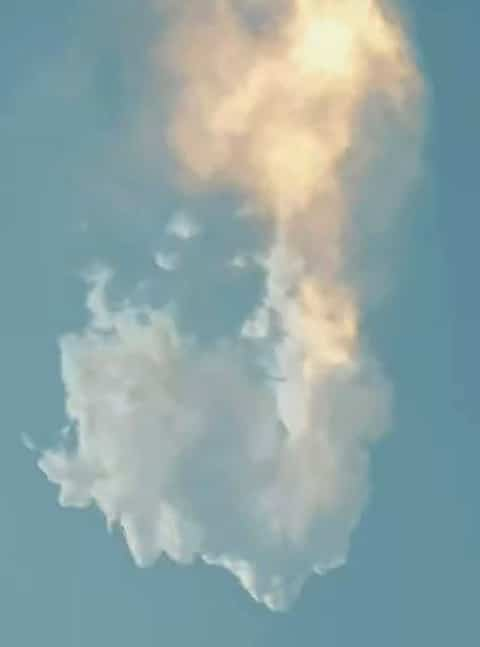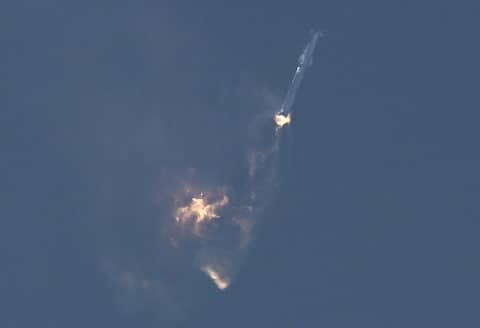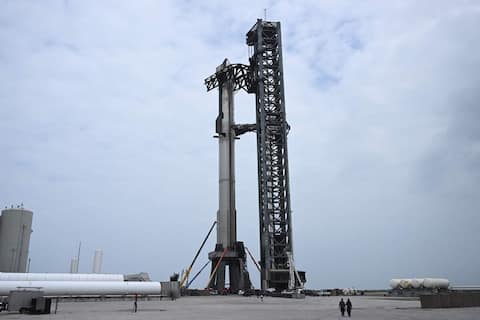The world’s largest rocket, the Starship, developed by SpaceX for flights to the Moon and Mars, exploded in the air shortly after take-off, but this first test flight has already brought the company a great success.
In a giant ball of fire, this 120-meter-tall black-and-silver behemoth ripped itself out of the ground around 8:30 a.m. local time, to cheers of joy from the SpaceX employees.
The scene of this highly anticipated scene was SpaceX’s Starbase, located in the far south of Texas, United States.
It is not yet known what caused the explosion. The purpose of this test flight was to collect as much data as possible to improve the next prototypes.
On Monday, the first launch attempt was canceled in the final minutes of the countdown, due to a technical problem.
“This is the first flight of a very large and complex rocket,” SpaceX chief Elon Musk said Sunday, describing the test as “very risky.”
At 120 meters, the Starship is larger than NASA’s massive new SLS rocket (98 meters), which first lifted off in November, and the legendary Saturn V, the Apollo lunar program’s rocket (111 metres).
The Starship’s thrust is also twice that of these two launchers – making it the most powerful in the world.
It has never flown before in its full configuration, with its super-powerful first stage, called Super Heavy and equipped with no fewer than 33 engines.
Only the second stage of the craft, the Starship spacecraft that gives its name to the entire rocket, has conducted suborbital tests (at an altitude of about 10 km).
It was he who was chosen by NASA to become, in a modified version, the probe for the Artemis 3 mission, which should return astronauts to the lunar surface for the first time in more than half a century. Officially in 2025.
- Listen to the proceedings of Loïc Tassé, specialist in international politics on Benoit Dutrizac’s mic at QUB Radio :
On Thursday, the flight plan was as follows: About three minutes after liftoff, the Super Heavy was to separate and return to the waters of the Gulf of Mexico. But this separation did not happen, the missile continued to spin before exploding.
If the separation is successful, the Starship will then have to fire up its six engines and continue its ascent on its own, up to an altitude of more than 150 km. Having achieved less than a course of about an hour, it was to plunge back into the Pacific Ocean.
But getting through all these steps on the first test flight would have been a real feat.
Elon Musk wanted to temper expectations, saying that reaching orbit on the first try was unlikely.
He was content with hoping that the launch pad would not be destroyed by the Super Heavy engines exploding on ignition.
“My biggest wish is, please (…) we are far from the launch pad before something goes wrong,” he said.
The rocket already has customers: the first manned flight of the Starship will take place with the American billionaire Jared Isaacman.
Japanese billionaire Yusaku Maezawa and American Dennis Tito (the first space tourist in history) also said they wanted to embark on a journey around the moon.
The spacecraft must be able to carry up to 150 tons of cargo into orbit. For comparison, a SpaceX Falcon 9 rocket can carry just over 22 tons into low Earth orbit.
But the real innovation of Starship is that it has to be fully reusable — something Elon Musk believes can be achieved in “two or three years.”
For this first test, no recovery of either rocket stage should be attempted. But in the end, Super Heavy will have to turn back and rest in front of the launch tower, equipped with arms to immobilize it.
The Starship will have to return to Earth using the retrorocket. It was this maneuver that was tried several times in 2020 and 2021. After several explosions on landing, a prototype finally managed to land.
The idea of a reusable launcher, Elon Musk’s grand strategy, is to cut prices. It is claimed that each flight on the spacecraft may end up costing only “a few million” dollars.
An absolute necessity for the billionaire, who estimates that humans would need hundreds of starship rockets to have a chance at becoming a multi-planetary species. Its ultimate goal is to establish an independent colony on Mars.

“Total coffee aficionado. Travel buff. Music ninja. Bacon nerd. Beeraholic.”






![[À VOIR] A SpaceX Starship rocket explodes mid-flight](https://m1.quebecormedia.com/emp/emp/c1c94070-df90-11ed-891f-ab7ac66c3d41_ORIGINAL.jpg?impolicy=crop-resize&x=0&y=153&w=1200&h=494&width=1200)




More Stories
Pennsylvania Primary: Good performance from… Nikki Haley!
US pushes TikTok towards exit
$1,800 for a “ministerial meeting” with foie gras in the office of André Laforest: PLQ accuses CAQ of mismanagement of public funds